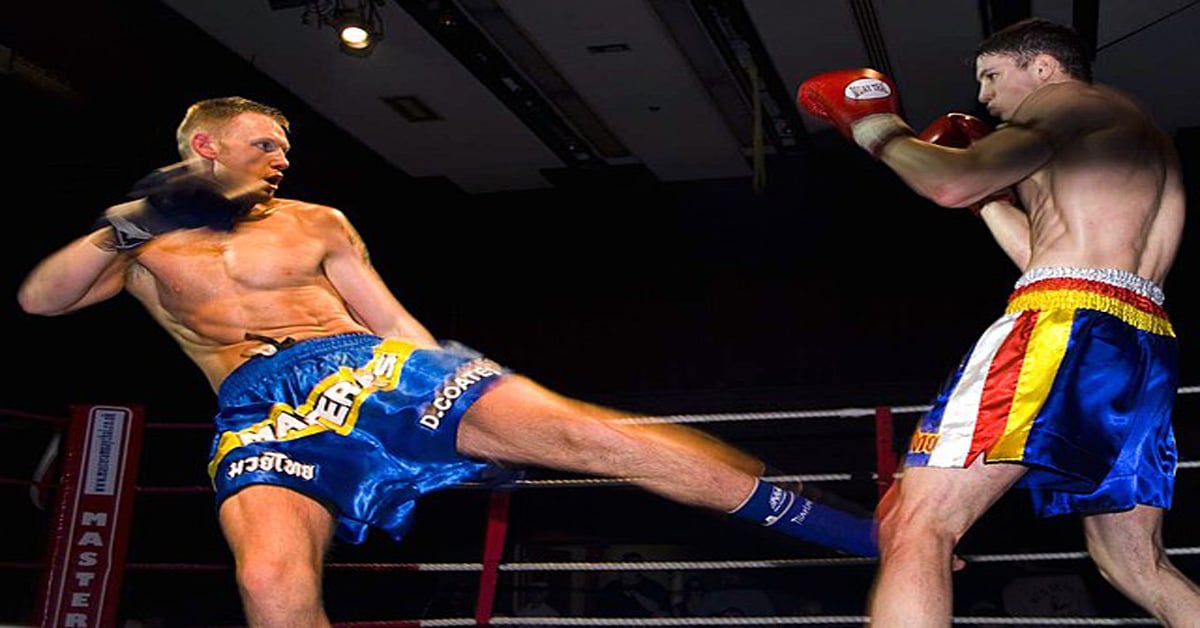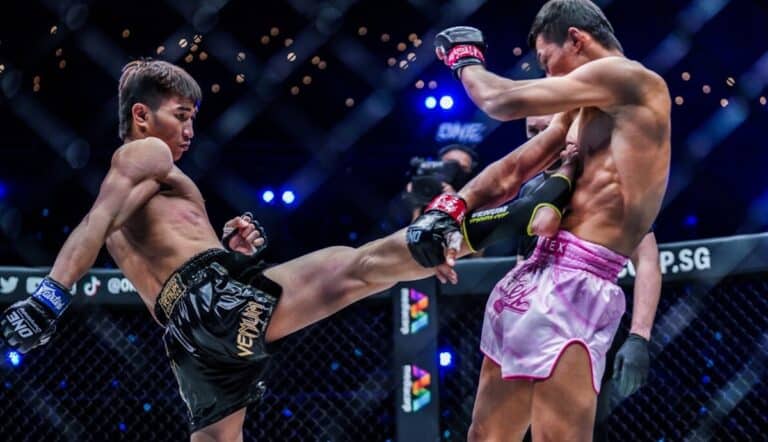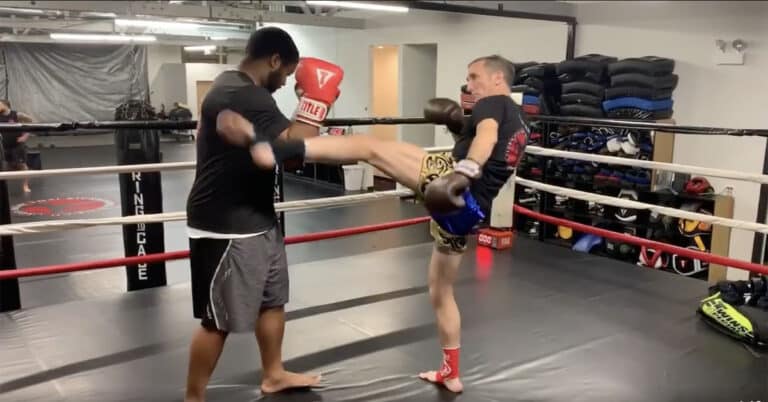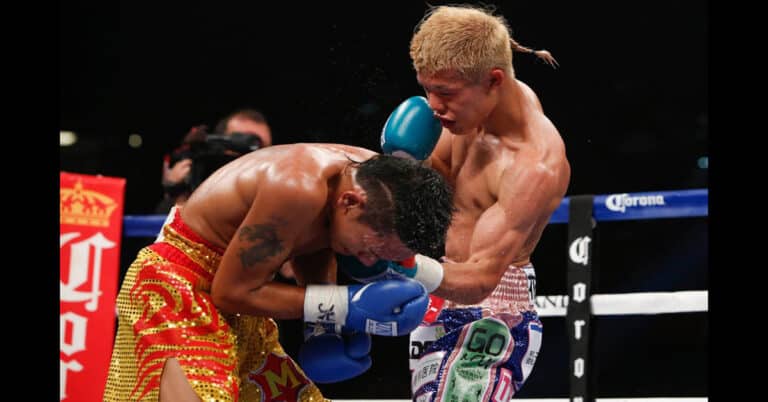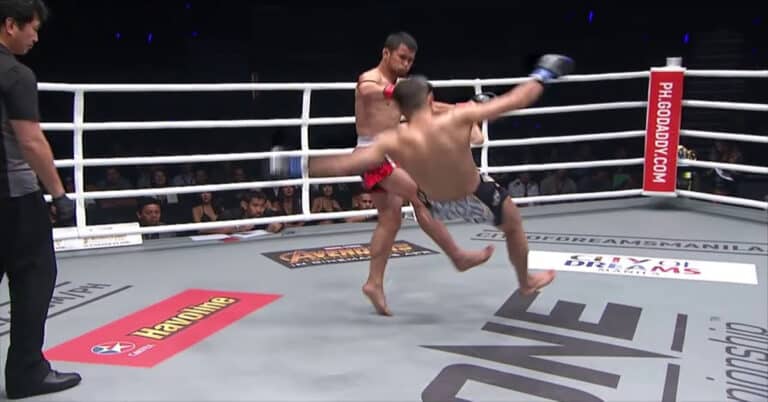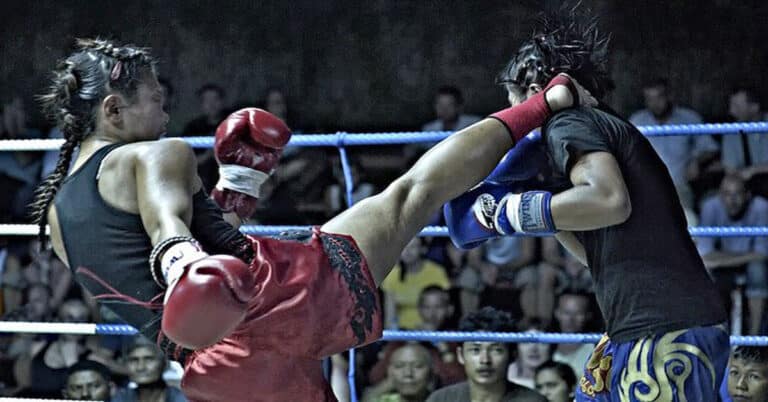Muay Thai Low Kicks: A Guide From the Experts
Muay Thai low kicks are a vital piece that a fighter must learn to master the Art of Eight Limbs. Muay Thai is a combat sport that has a full arsenal of attacks including punches, kicking, kneeing, and elbowing. A Nak Muay, or fighter, must master the basics of Muay Thai low kicks to be adept in this sport.
Every Muay Thai fighter at any level knows the importance of Muay Thai low kicks. The masters know the Muay Thai low kicks are a vital attack to have in one’s arsenal. It is a fundamental aspect of many fighters’ games including world champions Nong-O Hama, Tawanchai, Stamp Fairtex, Ernesto Hoost, Ramon Dekkers, Saenchai, Buakaw, Liam Harrison, and tons of others.
Becoming a master of Muay Thai low kicks will help a fighter in all combat sports, whether one is getting ready for a match in Muay Thai, kickboxing, or MMA, learning proper technique will be a pillar element of the match.
Muay Thai is a striking martial art that places a significant emphasis on powerful and precise kicks. Among the various techniques in Muay Thai, low kicks stand out as a fundamental and effective weapon. In this comprehensive guide, we’ll delve into the intricacies of Muay Thai low kicks, covering everything from their importance to training methods, expert advice, and more.
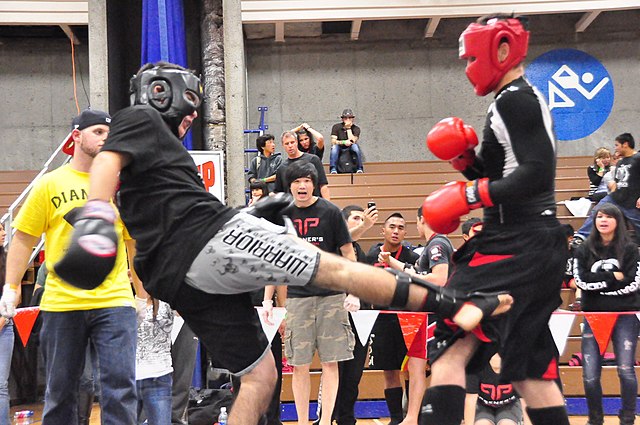
Top 3 Actions You Must Learn about Muay Thai Low Kicks:
1. Common Mistakes to Avoid
Mastering Muay Thai low kicks requires dedication and attention to detail. However, beginners often encounter common mistakes that can hinder their progress and compromise their performance. By identifying and rectifying these mistakes when learning Muay Thai low kicks, you can accelerate your learning curve and enhance your low-kick execution. Here are the most common hitches to watch out for:
Telegraphing the Kick
Novice fighters may inadvertently telegraph their Muay Thai low kicks by displaying obvious signs of intent before throwing the strike. This can tip off opponents, allowing them to anticipate and effectively counter the kick.
Lack of Hip Rotation
Effective low kicks hinge on proper hip rotation. Failing to engage your hips limits the power generated and results in weaker kicks that opponents can easily withstand. Keep in mind, this is true in Muay Thai and kickboxing, but is not always the case in MMA. Engaging the hips fully during a kick in MMA could potentially lead to getting taken down. However, learn the proper Muay Thai low kicks technique first then learn the strategy for when to apply it.
Poor Balance
Balance on one’s feet is the cornerstone of Muay Thai. Neglecting balance during Muay Thai low kicks leaves you susceptible to counters such as sweeps or trips, potentially compromising your position in the fight.
Ignoring Foot Positioning
Incorrect foot placement impacts the accuracy and force behind your Muay Thai low kicks. Paying attention to your lead foot’s positioning is vital to ensure your kick’s trajectory and effectiveness.
Overcommitting
Excessive force behind low kicks can lead to exhaustion and a loss of control. Beginners should focus on maintaining technique and distributing energy efficiently throughout the match. One can drill this on a heavy bag, on the pads, or with a partner.
2. Incorporating Low Kicks into Strategy
Low kicks are not just about raw power; they’re a strategic tool that can shape the course of a fight. By integrating Muay Thai low kicks into your overall game plan, you can gain a competitive edge and keep your opponents guessing. Here’s how:
Range Management
Proper low kicks enable you to dictate the distance between you and your opponent. Employing well-timed low kicks can maintain a safe range and disrupt your opponent’s rhythm, giving you the upper hand.
Setting Up Other Strikes
Low kicks set the stage for a variety of follow-up attacks. Combining Muay Thai low kicks with punches, knees, or high kicks can catch opponents off guard, creating opportunities for effective combinations. For hints on how to do this effectively, see Ernesto Hoost and Liam Harrison.
Weakening the Opponent
Consistently targeting your opponent’s legs with low kicks can impede their mobility and overall performance. Gradually wearing down their leg muscles hampers their movement and makes them more susceptible to other strikes. Fighters such as Buakaw, Ernesto Hoost, and Liam Harrison was experts in this area.
3. Conditioning and Flexibility
Executing powerful Muay Thai low kicks requires more than just technique; it demands proper conditioning and flexibility. Strengthening the necessary muscle groups and enhancing flexibility can take your low kicks from journeyman to master. Here’s how to achieve that:
Strength Training
Prioritize strength training exercises that target the quadriceps, hamstrings, and hip flexors—the key muscles involved in Muay Thai low kicks. Incorporate squats, lunges, and leg presses to build the required lower body strength.
Flexibility Routines
Adequate flexibility is crucial for executing low kicks with optimal range of motion. Engage in dynamic stretching routines that focus on the hips, groin, and lower body. Improved flexibility enhances your kicks and reduces the risk of injuries.
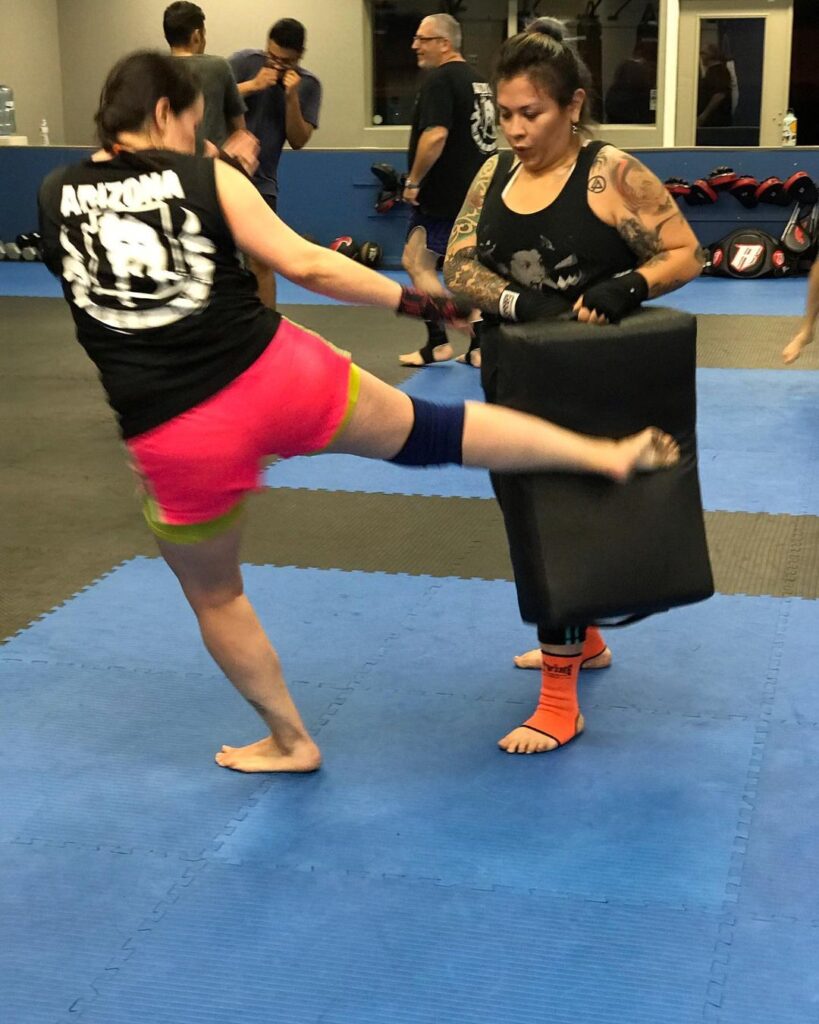
Muay Thai Low Kicks as Taught by the Masters
Sam-A Gaiyanghadao
Sam-A Gaiyanghadao is a master of Muay Thai. The Thai-born athlete has earned gold multiple times in Lumpinee Stadium and ONE Championship, and elsewhere. With nearly four hundred career victories to his name, he is an expert on Muay Thai low kicks. He has a guide on bad drills a Nak Muay should be doing to improve their Muay Thai low kicks.
Sam-A Gaiyanghadao teaches:
- Establishing the Foundation: Step and Positioning
Begin by stepping diagonally forward and out with your front leg, planting your foot firmly into the mat. For an added boost of power, consider a small jump forward. This initial movement sets the stage for generating maximum force in your low kick. - Engaging the Hips and Shoulders: Pivot and Turn
With your knee bent, initiate a pivot on your front foot. Simultaneously, turn your hips and shoulders in the direction of your strike. This rotational movement harnesses the energy from your lower body, channeling it into the strike of your rear leg. - Precision and Motion: Swinging Down, Not Across
Imagine your leg as a powerful axe as you arc your shin downward onto your opponent’s thigh. Focus on a chopping motion rather than a baseball bat-like swing across. This technique optimizes impact and prevents unnecessary strain on your joints. - Generating Power and Balance: Utilize Your Rear Arm
As your rear leg swings forward, your rear arm swings back in a coordinated motion. This movement generates additional power and aids in maintaining balance throughout the kick. The synchronization of arm and leg movements enhances the effectiveness of your strike. - Targeting and Positioning: Aim Past the Mark
Aim with your knee slightly beyond your target. With your leg slightly bent, guide your shin to connect precisely where you intend to strike. This precision ensures that your low kick lands in the optimal spot, maximizing its impact. - Defense and Evasion: Lower Stance and Head Movement
Lower your stance slightly as you execute the kick. Simultaneously, shift your head off the centerline, moving it away from your opponent’s potential punches. This defensive adjustment protects you from immediate counters, allowing you to maintain control of the engagement. - Returning to Ready: Reverting to Stance
After the kick, smoothly return to your fighting stance. This seamless transition prepares you for any follow-up actions and maintains your readiness to defend or launch subsequent attacks. - Guarding Your Space: Maintain a Tight Defense
Throughout the entire sequence, ensure that your guard remains intact. Position your head and shoulders to offer protection on one side, while keeping the opposite hand raised. This defensive posture reduces vulnerabilities and maintains your readiness.
Liam Harrison
The UK-born Liam Harrison is one of the all-time great Muay Thai fighters in the history of the sport. Among many world championships to his name, he is also a highly touted coach. In coaching and fighting his specialty technique is the Muay Thai low kick.
Liam Harrison teaches:
- Manipulating Body Position:
The purpose of the pummeling motion is twofold. First, it’s used to manipulate the opponent’s body position to create an opening for landing the low kick. Second, it’s employed to assess the opponent’s weight distribution to determine the viability of the kick. - Understanding Weight Distribution:
Harrison emphasizes the importance of understanding the opponent’s weight distribution. For instance, if the opponent’s weight is on their back foot, they can easily lift their leg to block a low kick. Conversely, by pushing and feeling the opponent’s weight shifting back onto you, you can create an opportunity to execute the kick effectively. - Drawing Out a Reaction:
The goal is to provoke a reaction from the opponent. By pushing your weight onto the opponent, you’re encouraging them to push back against you. This interaction sets up a situation where you can exploit their weight distribution to your advantage. - Utilizing Weight Shift for a Free Kick:
Harrison mentions that when the opponent pushes back against your weight, you can release your weight forward. This shifting of weight can catch the opponent off guard and leave them vulnerable to a low kick. Essentially, you’re using their own momentum against them. - Angle and Speed of the Low Kick:
The angle of the low kick is crucial. Harrison demonstrates that the low kick is not coming all the way across, as it would be too slow. Instead, it’s delivered at an angle that is quick and effective. The angle of the kick allows it to land before the opponent can react. - Timing the Kick:
Harrison explains that as you feel the opponent’s weight shift onto you, that’s when you release your weight forward and execute the low kick. Timing is essential to catch the opponent when they’re off-balance and less able to defend against the kick. - Continued Pressure and Attack:
Harrison highlights that if the opponent starts to move away or push back, he recognizes the need to adjust his strategy. He continues to pressure and assess the situation, waiting for the right moment to execute the low kick.
Final Thoughts
The Muay Thai low kick is not as simple as it seems. One must consider timing and accuracy when using this strike, in addition to flexibility, speed, and strength. It is a cornerstone of kickboxing, Muay Thai, and MMA. An effective low kick can take an athlete’s game from adept to knockout artist.
A fighter must learn the proper technique because if thrown incorrectly it can lead to a broken leg. There is no strike more powerful than a kick, however, it can be dangerous to one’s opponent and one’s self. It is vital to learn about this attack from the experts. Work in the gym with your coach to learn this properly.

